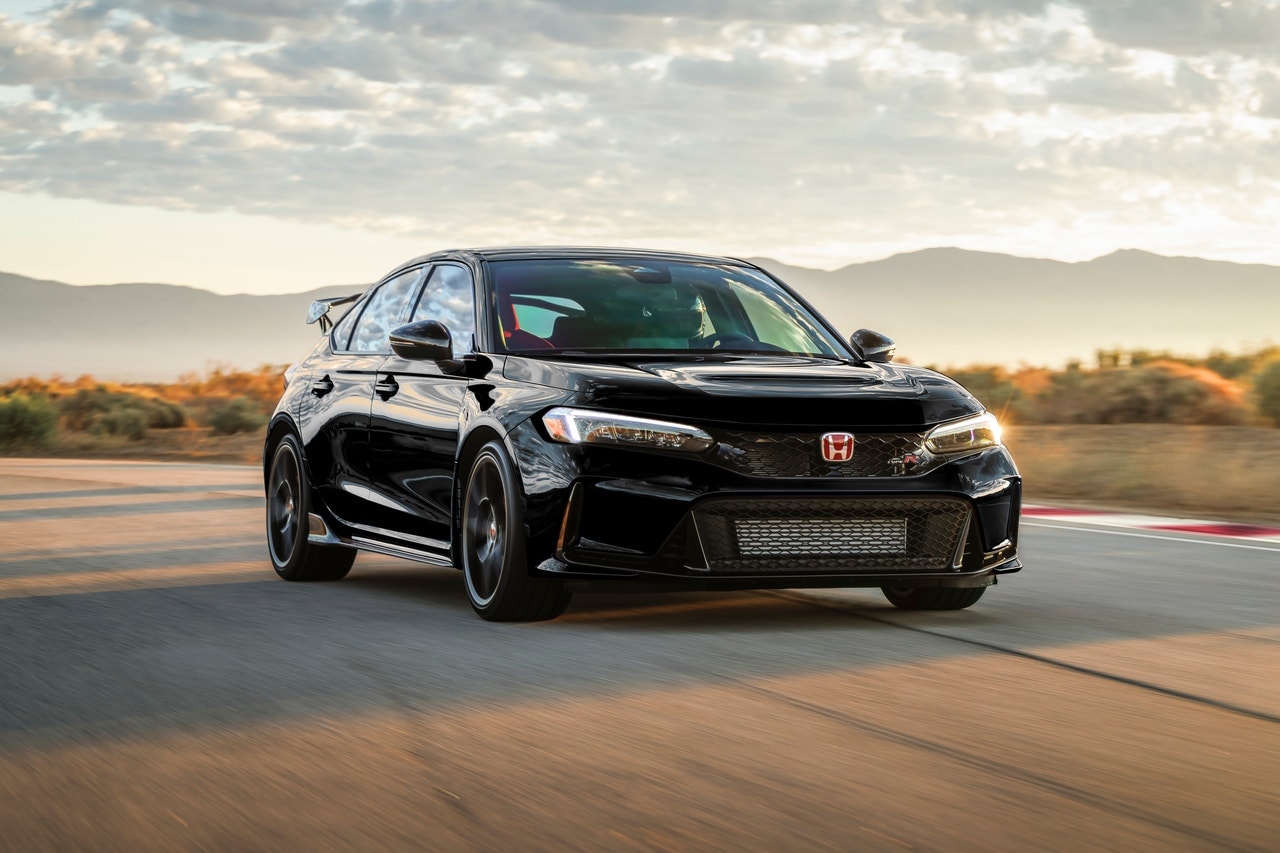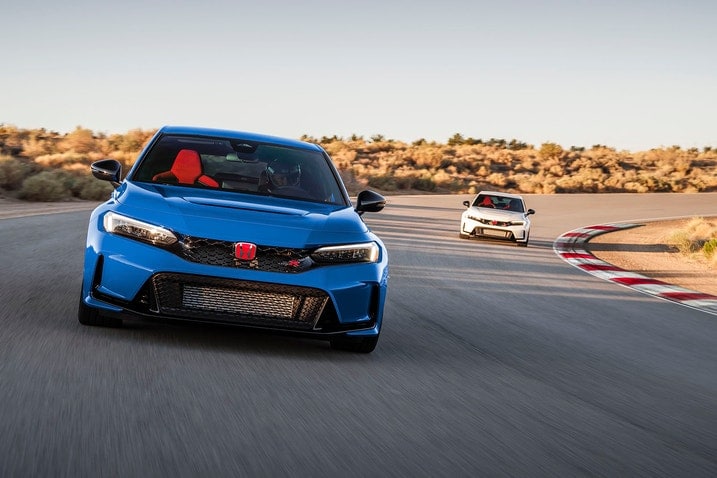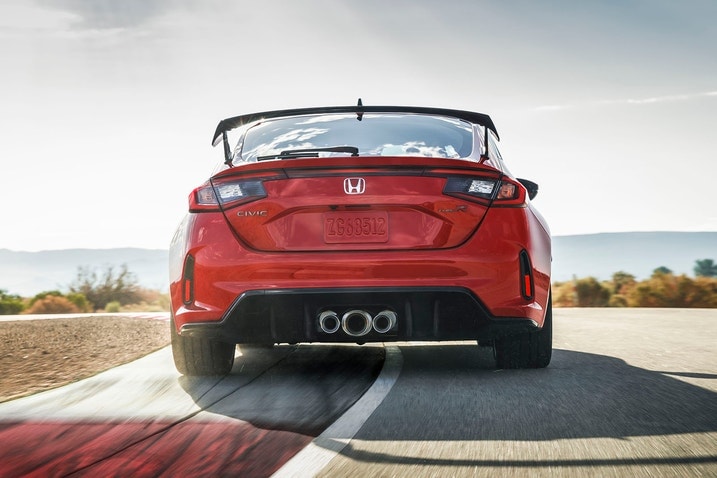- The new Civic Type R is a superlative hot hatch.
- But some might wonder how it compares to the old one and if it's a meaningful upgrade.
- That's the question we answer here.
2023 Honda Civic Type R Review: Still the GOAT?
Take it from a former owner: The answer is yes
Honda first rolled a Civic Type R off a production line in Suzuka in September of 1997 and it's hardly stopped since. Since the original EK9 (the internal generational code all Civic Type Rs can be identified by), there have been six generations of CTR, each whittling away at the formula a little more, looking for a little extra edge in the quest for hot-hatch supremacy. The FK8 (2017-2021) was the first time Americans got their hands on a Civic Type R, and it was so good it saddled the 2023 FL5-generation car with more expectation than its cargo hold can cope with.
On first glance there isn't really that much to get excited about. The 11th-generation Civic is based on the 10th-generation one, and the major changes from old to new amount to manufacturing processes that result in a stiffer chassis and tighter tolerances. The engine, which is largely the same KC201 2.0-liter turbocharged four-cylinder as found in the last Type R, makes 9 more horsepower and 15 more lb-ft of torque than before and features a more robust cooling package. The new Type R also gets wheels that are an inch smaller in diameter but 20 millimeters wider than before, a longer wheelbase, and wider tracks front and rear. Oh, and it doesn't look like a Gundam had a baby with a Zoid (Google it) anymore.
This sort of minutia typically draws yawns from enthusiasts. Perhaps even more mundane, the new CTR is so composed on the day-to-day, you could easily be fooled into thinking you're in a regular Civic hatchback. Despite the interior's race-car aspirations, it's easy to drive around town, and the engine doesn't make much of an impression below 3,500 rpm. The light clutch and gear lever make tooling around easy, and the masses of space afforded by its 24.5-cubic-foot cargo hold make it an ideal everyday companion for hauling groceries, going on longer trips, or even moving (as this writer happened to do).
But the old car was comfortable on the road and its cargo hold was nearly as massive. It even offered up similar power, weighed slightly less, and was more affordable. There's very little that, on paper, proves unequivocally that the new Type R is better than the old one, and that will come as a disappointment to some. But the new Type R knows its pedigree. It sweats the small stuff and fully believes the devil is in the details. The results of all those little changes don't really show up on paper or during the daily bump and grind — instead, they only make a difference once you really start to pay attention.
And right about now is where I should come clean. The reason this review is chock full of comparisons to the old car is because yours truly owned one for a year. It wasn't a car that was lent to me by Honda for a long-term test but one I purchased with my own money. I thought it was just so gosh-darn good that I had to have one. It was a 2019 (because I needed that volume knob) in Aegean Blue (a color I wish Honda had brought back). After I swapped the stock Continentals for a set of Michelin Pilot Sport 4Ss (the same tire that comes as standard on the FL5) it was my idea of the perfect hot hatch.
Then I got into the new one. It starts with the driving position and that teardrop-shaped aluminum gear lever. You sit low down in the heart of the car — you are at the center of the action in that eminently supportive, blood-red suede bucket seat. The clutch action is linear and direct, as are the throws from the snickety gear lever. It's been said before and it's no exaggeration, the gear shift in the Type R is one of the cleanest and most precise on sale right now. You'd have to move to a Porsche Cayman GT4 to get similar satisfaction as you whirl the lever from gate to gate.
But the differences between the new Type R and the old one get thrown into stark relief when you start to push it. The old car could feel a little skittish at the limit. There was a lot more going on as it squabbled around for grip and skipped over bumps. That's all gone in the new Type R — it's all about composure now. The wider front track and wider wheels make an immediate difference and imbues you with even more confidence than the old car did. There are few cars, at any price, that will back you up as stoutly as the new Type R will.
It stops, steers, and goes like little else in its class and like no other front-wheel-drive car before. The only limit is how quickly you dare toss the new CTR into the corner because, as far as the car is concerned, any corner is liable to be taken at any speed. Grip is unflappable, and Honda's clever front limited-slip differential helps drag you out of corners without spinning up the inside wheel at the front. The rear sticks, too. The last car could be coerced into accidental oversteer midcorner with a tap of the brakes, but the new car is so planted that you won't get the tail out unless you're out on track being a real hooligan.
Yet there's something beyond just the capability. Fast cars aren't always engaging experiences, and many of them feel anodyne in their delivery. Not here. The steering communicates the road surface beautifully, and the suspension (while firmer than the one in the car before) gives your backside an excellent idea of what's going by underneath it.
Thanks in part to a new, lighter flywheel, the engine pulls willingly all the way to its 7,000 rpm redline, and it's worth wringing out. The brakes give you full bite at the top of the pedal and don't relent as you dig further in. Everything about the new Type R is dialed in and carries the sort of refinement reserved for much more expensive machinery. There is a Porsche-like relationship between the throttle, brakes, steering, clutch and gear lever. They don't come together so much as they belong together.
That is where the biggest difference between the FK8 and the FL5 lies. Not in the numbers, the interior space or overall capability (the old car is still brilliant, frankly). But the one biggest differentiator is in how much more complete the new car is when it's time to cut loose. Everything from the brake pedal to the revised gearshift to the extra mechanical grip is 10% or 15% better than the old car. If the FK8 was a talented apprentice, the FL5 is the master of its craft.
After the honing, tuning and late-night-oil-burning the engineers did, the FL5 certainly lives up to its predecessor. It does plenty more than that, actually. It takes a winning formula and sharpens it ever further, ironing out rough edges, and dialing out imperfection to create what is one of the best hot hatchbacks ever put on sale. The FL5 Civic Type R is a car that's been loved, dreamt about, and obsessed over in the quest for something that is truly world-class. Perhaps not surprisingly, that's exactly what Honda created.
Edmunds says
The FL5 is likely the last purely internal-combustion Type R we'll ever see, but we're glad Honda is sending it out with such a massive bang.









 by
by